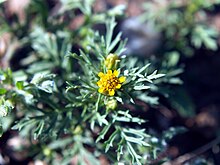Dyssodia papposa
| Dyssodia papposa | |
|---|---|

| |
| Scientific classification | |
| Kingdom: | Plantae |
| Clade: | Tracheophytes |
| Clade: | Angiosperms |
| Clade: | Eudicots |
| Clade: | Asterids |
| Order: | Asterales |
| Family: | Asteraceae |
| Genus: | Dyssodia |
| Species: | D. papposa
|
| Binomial name | |
| Dyssodia papposa | |
| Synonyms[1] | |
| |
Dyssodia papposa is a species of annual herbaceous forb in the genus Dyssodia, commonly known as fetid marigold or prairie dogweed.[1][2] It is native to North America and parts of the Southwest, extending into the Northeast. The plant has been used by Native Americans to treat multiple medical conditions.
Description[edit]
Fetid marigold is a erect multi-branching annual with a large taproot, common to anthropogenically disturbed areas such as roadsides, fields, and meadows, at elevations from 3000–6500 ft (914–1981 m).[3][4][5] Its height is 4–16 inches (5–70 cm). The leaves are simple and opposite, 3/4 in to 2 in (15–50 mm) long and linearly lobate.[6]
The flowers have the disk and ray structure characteristic of the Asteraceae family; both are yellow-orange, up to 1/2in long with 5–8 ray flowers which are up to 3.5cm long and 1.5 cm wide, with tubular disk flowers and greenish outer and inner bracts. Seeds are small, hairy, narrowly conical with a tuft of bristle at the top, dark brown in color when mature. Distinctive orange odor glands dot the stalk, leaves and stems of the plant, which are the source of its characteristic scent.[4][6][7] It flowers in summer to fall. The name dyssodia is from the Greek δυσοδια (dusodia), meaning "bad odor", while papposa is from the Latin meaning "with pappus".[8]
Its native range includes the central plains of North America and parts of the Southwest, extending into the Northeast.[1] It has recently been documented in Canada, where it is expected to expand its range via adventitious growth.[3][9]
Ecology[edit]
The plant is host to the dainty sulphur butterfly.[8] It is commonly found in prairie dog towns and is among their preferred food sources.[2]
Ethnobotany[edit]
Fetid marigold was given to horses for coughs by the Dakota, used as a febrifuge and smoked for epilepsy by the Keres, applied to red ant bites by the Navajo, and was used by the Lakota as a treatment for headaches, internal bleeding and breathing difficulties.[10] The Omaha reportedly used it to induce nosebleeds to cure headache.[10] Seeds were ground into flour for bread or roasted without grinding and combined with other foods by the Apache, who also ate the tops of the plant as greens.[11]
References[edit]
- ^ a b c "Dyssodia papposa (Vent.) Hitchc. fetid marigold". USDA Plants. United States Department of Agriculture Natural Resources Conservation Service. Retrieved 18 October 2021.
- ^ a b Summers, C. A.; Linder, R. L. (1978). "Food habits of the black-tailed prairie dog in western South Dakota" (PDF). Journal of Range Management. 31 (2): 134–136. doi:10.2307/3897663. Retrieved 18 October 2021.
- ^ a b Oldham, Michael J.; Klymko, John (1 September 2011). "Fetid Dogweed (Dyssodia papposa; Asteraceae) in Canada". Northeastern Naturalist. 18 (3): 347–356. doi:10.1656/045.018.0307. Retrieved 19 October 2021.
- ^ a b "Dyssodia papposa". Go Botany. Native Plant Trust. Retrieved 19 October 2021.
- ^ "Dyssodia papposa, Fetid Marigold". Southwest Desert Flora. Retrieved October 23, 2021.
- ^ a b "Dyssodia papposa (Fetid Marigold)". Minnesota Wildflowers. Minnesota Environment and Natural Resources Trust Fund. Retrieved 19 October 2021.
- ^ "Dyssodia papposa Dogweed". The Jepson Herbarium. University of California, Berkeley. Retrieved 19 October 2021.
- ^ a b "Dyssodia papposa". SEINet. Southwest Biodiversity. Retrieved 19 October 2021.
- ^ Oldham, Michael J.; Gould, Joyce; Bowles, Jane M. (2011). "Fetid Dogweed (Dyssodia papposa; Asteraceae) and Slender Russian Thistle (Salsola collina; Amaranthaceae), New to Alberta, Canada". Canadian Field-Naturalist. 125 (4): 366–369. doi:10.22621/cfn.v125i4.1267. Retrieved 19 October 2021.
- ^ a b Moerman, Daniel E. (2009). Native American Medicinal Plants. Timber Press Inc. p. 177. ISBN 978-0-88192-987-4.
- ^ Castetter, Edward F.; Opler, M. E. (1936). "The Ethnobiology of the Chiricahua and Mescalero Apache". University of New Mexico Bulletin. 4 (5): 1–63. Retrieved 19 October 2021.

